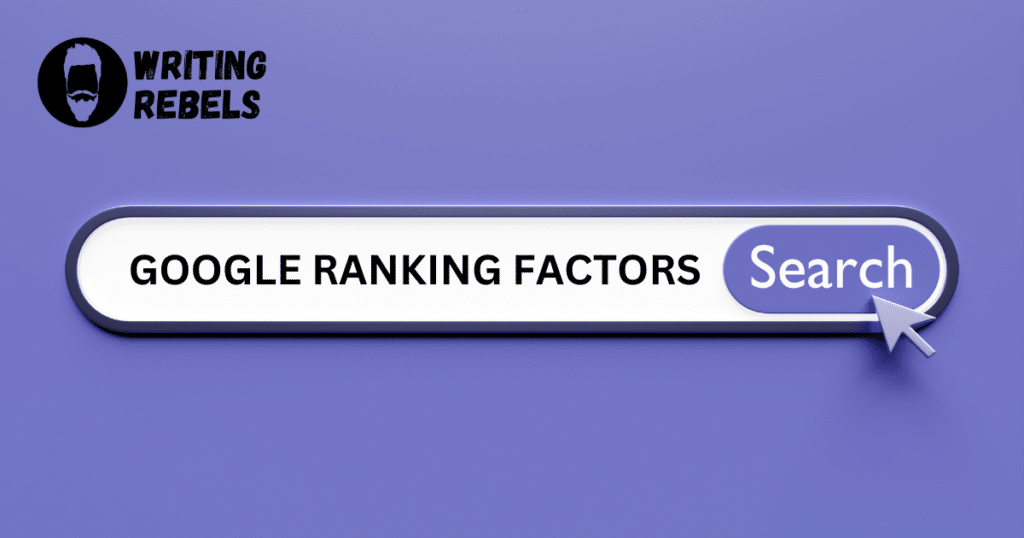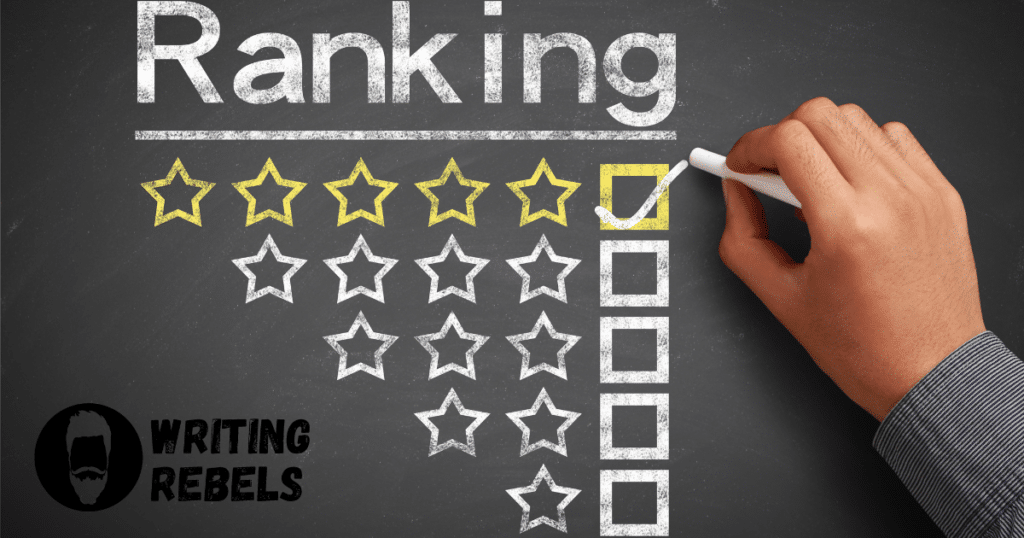
Have you ever looked into Google ranking factors to leverage your SEO strategy?
Do you want to see your website rise in Google rankings? Of course you do. However, for many, the ranking system seems to be playing against them even when they are creating quality content. So, what gives?
We completely empathize with your pain, having been in a similar situation. After extensive research and exploration, we’ve discovered the top 7 strategies that propel websites to the first page of search results.
Google wants you to focus on search engine optimization (SEO), but Google doesn’t want you to overdo it and look spammy or robotic. Things like on-page SEO are important for Google search ranking, but so are things like your core web vitals. You need to signal to Google that you’re checking the boxes they’re looking for to get into the search engine results.
In this article, we will dive deeper into seven tips to boost your ranking by looking at some SEO ranking factors. If you’re ready to boost your ranking on Google, let’s jump right into the guide to Google ranking factors for SEO!
Key Takeaways: Google Ranking Factors and SEO Ranking Factors
- Make sure Google can find and list your site by solving indexing issues. Use tools like Google Search Console.
- Get strong backlinks to boost your site’s authority. Sites with good backlinks rank higher in search results.
- Place links inside your site wisely to help search engines find important pages. This helps users, too.
- Create a great experience for users on your website. Increased page speed and easy navigation improve rankings.
- Choose the right keywords for each page and match them with the content. Focus on one main idea per page.
- Keep checking what others in your field do with their content. Fill in gaps where you can do better or offer something new.
- Pay attention to technical SEO aspects, such as managing pages that don’t get traffic or links, to improve performance.
Google Ranking Factor 1: Crawlability and Indexability

Crawlability and Indexability are crucial for website ranking. Addressing common indexing issues is essential to ensure your site is easily accessible to search engine bots and is one of the essential Google ranking factors you need to look at.
Essential for website ranking
We need to make sure Google can find and list our pages. If it can’t, our site won’t show up in search results. We use a special tool in Chrome or Firefox to check if Google can see our pages.
We look for “index follow” or no tag at all in the robots tag on each page — this tells us Google is allowed to add the page to its search index. Avoiding “no index” tags is key because they stop Google from listing a page.
For our sites to rank well, we keep track of how easy it is for Google’s bots to crawl and understand them. Solving common issues with indexing means more people can find us through Google search.
This step is crucial for showing up online and reaching more readers.
Checking and resolving common indexing issues
We know websites must appear on Google to get seen. If your site doesn’t show up, you have indexing issues. Let’s fix them together.
- Use Google Search Console. This tool tells us if Google can find your pages.
- Check for noindex tags. These tags tell Google not to show a page in search results. Make sure the pages you want seen don’t have them.
- Look at your robots.txt file. This file can block Google from seeing parts of your site. Ensure it’s not stopping important pages from being found.
- Fix broken links on your site. Broken links can stop Google from indexing your site well.
- Improve site speed. Pages that load faster are easier for Google to index.
- Make sure content is high-quality and original. Google likes unique information that helps users.
- Build more backlinks to your website from other sites. It shows Google your site is valuable, helping with indexing.
- Update content regularly so it stays fresh and interesting.
By doing these steps, we make it easier for Google to find and rank our pages higher in search results.
Google Ranking Factor 2: Website Backlink Authority

Website Backlink Authority plays a crucial role in SEO and is one of the Google ranking factors you need to leverage. Enhancing the site’s authority with strong backlinks greatly impacts its search engine ranking. It helps build trust and credibility, signaling to search engines the relevance and quality of the content on your website.
Importance of a strong backlink profile
A solid backlink profile helps Google find and trust our site. It’s like a thumbs-up from other sites. This boosts our site’s authority and ranking. Sites with strong backlinks get indexed faster.
They show up higher on search results.
Websites lacking good backlinks face trouble. Their pages don’t show up easily in searches. To solve this, we focus on getting more quality backlinks. This moves us up in rankings faster than those without them.
Overcoming indexing issues with site authority
- Growing site authority is crucial for overcoming indexing issues.
- Ensure your website has high-quality content and authoritative backlinks to improve site authority.
- Consistently create valuable content that attracts natural backlinks from reputable websites.
- Utilize social media platforms and industry-related forums to promote your content and build brand recognition.
- Engage in guest posting on relevant and established websites to establish your site as an authority in your industry.
- Develop relationships with influencers in your niche to gain endorsements and increase your site’s credibility.
- Focus on providing a seamless user experience to enhance engagement and trust, contributing to improved site authority.
Google Ranking Factor 3: Internal Link Coverage

Internal link coverage plays a crucial role in optimizing site architecture for search engines. By strategically placing internal links, we can guide search engine crawlers to key pages and distribute link authority effectively, which is why this is an important Google ranking factor.
Incorporating existing backlinks into our internal linking strategy also strengthens the overall site authority and enhances visibility.
Optimizing site architecture for internal link coverage
Optimizing the architecture of your site is crucial to ensure proper internal link coverage. Here are the key steps to follow:
- Ensure clear and concise website architecture
- Create a logical structure for easy navigation
- Use descriptive anchor text for internal links
- Maintain a balance between external and internal links
- Utilize sidebar and footer links strategically
- Regularly audit and update internal links for relevance
- Implement breadcrumbs for improved user experience
Bonus tip for driving internal links from pages with existing backlinks
To boost performance, consider driving internal links from pages with existing backlinks. This can leverage the authority of those linking pages to strengthen the destination page’s visibility and ranking.
By strategically placing internal links on high-authority pages, we can effectively channel some of that link equity to the target page, signaling its importance to search engines.
This practice helps reinforce the value and relevance of our content in Google’s eyes by ensuring that authoritative pages within our website are vouching for it. For example, if a well-linked blog post mentions a specific service or product, linking this mention to related landing or service pages could significantly enhance their perceived importance and, hence, their respective rankings.
Google Ranking Factor 4: User Experience (UX)

Next, on our list of Google ranking factors is user experience. Improving user experience boosts the site’s appeal. Entities like web page loading time and mobile compatibility impact UX. Enhancing these elements elevates user experience, increasing site engagement.
This leads to better Google rankings because they prioritize rewarding sites that provide a seamless browsing experience.
Components of a good UX
Good UX (User Experience) is crucial for website success. It involves making sure users find what they need quickly and have a positive interaction with your site.
Here are the components of a good UX:
- Simple Navigation: Users should easily find what they’re looking for on your website.
- Clear Call-to-Action Buttons: Apparent buttons prompt users to take specific actions, such as signing up for a newsletter or making a purchase.
- Responsive Design: Your website should work well on all devices, including mobile phones and tablets.
- Fast Loading Time: Users expect websites to load fast. A slow website can lead to frustration and abandonment.
- Engaging Visuals: Images and videos that relate to your content can keep users interested.
- Readable Content: Use clear fonts and colors that make text easy to read.
- Error-free Functionality: Ensure there are no broken links or error messages that disrupt the user experience.
These are essential aspects of a good UX that bloggers and content creators must consider when optimizing their websites for better search engine rankings.
Tools for analyzing engagement and interaction
We can use Google Analytics to track user behavior on our website. Other helpful tools include Screaming Frog and Mouseflow, which provide insights into engagement and interaction.
These tools help in discovering areas for improvement and understanding how users interact with the site’s content and is one of the Google ranking factors you shouldn’t overlook. With this data, we can make informed decisions to enhance user experience and boost our site’s performance.
Google Ranking Factor 5: Keyword Placement

Emphasize matching keywords with page content to boost your site’s visibility. Hyper-focus on one primary service offering and location per page for maximum impact. Your actual keyword placement is one of the key Google ranking factors.
Importance of matching keyword intent with page content
Matching keyword intent with page content is crucial for improving search engine rankings. When we align the words and phrases on our web pages with what users are searching for, it signals to search engines that our content is relevant to those queries.
For instance, if someone searches for “best pizza in New York,” a webpage about New York pizza should include related keywords like “pizza places in NYC” or “authentic New York-style pizza.” By doing this, we help Google better understand our content and increase the chances of ranking higher on search results for those specific queries.
It’s also important to avoid mixing multiple intents or trying to rank for multiple locations on one page, as it can dilute the relevance of the content.
Emphasizing hyper-focus on one primary service offering and location per page
When it comes to focusing on one primary service offering and location per page, it’s important to ensure that your content revolves around a specific service or product you provide in a particular area.
By doing so, you are tailoring the information to match the needs and intentions of users searching for that specific offering in that location. This approach not only improves user experience but also increases the relevance of your web pages in search results.
Moreover, this hyper-focus strategy allows search engines to clearly understand what your page is about, making it more likely for them to display it when users search for related queries within your targeted location.
As bloggers and content creators, incorporating this method into your SEO practices can significantly improve your chances of ranking higher on Google and attracting potential customers who are actively seeking the exact services or products you offer in their vicinity.
Google Ranking Factor 6: Better Content to Rank Higher on Google

Content is a critical part of SEO. Analyzing competitors can help identify content gaps and refine our own content for relevance, ensuring it resonates with the audience.
Conducting competitor analysis and identifying content gaps
When analyzing competitors and identifying content gaps, we aim to understand their strengths and weaknesses:
- Utilize tools like Ahrefs, SEMrush, or Moz to assess competitor backlink profiles and identify potential link opportunities.
- Compare the structure and depth of competitor content to determine areas for improvement in our own content strategy.
- Evaluate keyword usage in competitor content to identify untapped keyword opportunities for our own website.
- Analyze social media engagement, site traffic, and user interactions to gauge audience preferences and trends.
- Uncover content themes that resonate with the target audience using sentiment analysis tools like Brandwatch or Sprout Social.
- Pinpoint gaps in competitor content by creating a list of keywords they aren’t targeting but could benefit from including within our strategies.
- Assess top-performing competitor pages based on search rankings and engagement metrics to emulate successful tactics.
By conducting this analysis, we can enhance our understanding of how to position our website competitively while addressing content gaps effectively.
Crafting and refining content for relevance in Google algorithm
Crafting and refining content for relevance is crucial for improving page ranking. To enhance the page’s relevance, we should focus on adding relevant sections and keywords. Utilize SEO tools and human editors to craft and refine content.
This combination ensures that the content remains relevant while appealing to readers.
Crafting and refining content involves analyzing what users are searching for, understanding their intent, providing valuable information, and utilizing the right keywords.
It’s important to conduct competitor analysis to identify gaps in existing content that can be addressed on our platform by crafting new material or enhancing existing pages with more detailed information.
Google Ranking Factor 7: Technical SEO

Technical SEO is crucial for optimizing your website’s performance. Identifying and managing pages with zero traffic, impressions, and backlinks are essential for improving your site’s visibility and search engine ranking.
Making informed decisions based on positive contributions will enhance your overall SEO strategy.
Identifying and managing pages with zero traffic, impressions, and backlinks
What happens when we find pages with no traffic, impressions, or backlinks? Here’s what we do:
- We analyze the pages to decide whether to delete, redirect, consolidate, or improve them.
- We gather statistical data about each page for informed decision-making.
- We consider the impact of removing or revamping these pages on our site’s overall performance and user experience.
- We seek out examples of successful strategies implemented by others in similar situations.
- We utilize tools to track and measure the performance of our website pages over time.
- We establish a timeline for taking action on these underperforming pages based on their criticality to our site’s goals.
- We prioritize improving user engagement and relevance when deciding how to handle each page.
Making decisions based on positive contribution in the ranking system
We analyze data to identify pages with no traffic, impressions, and backlinks. That way, we decide what content contributes positively. We don’t get swayed by past commitments. We only keep content that adds value.
The approach is simple — if a page doesn’t help users or the site’s performance, we remove it. This way, we ensure our website offers quality and relevant content.
Leverage Google Ranking Factors for SEO
There are so many important Google ranking factors out there that can affect where you are in the Google search results. In fact, there are over 200 ranking factors, and we looked at the top seven to help boost your ranking signal so that Google may bless you with getting on the first page of the SERPs.
Disclaimer: Some of the links in this article may be Amazon affiliate links and provide us with a very small commission. This does not affect the price on your end, but should you decide to make a purchase, we appreciate your support.

